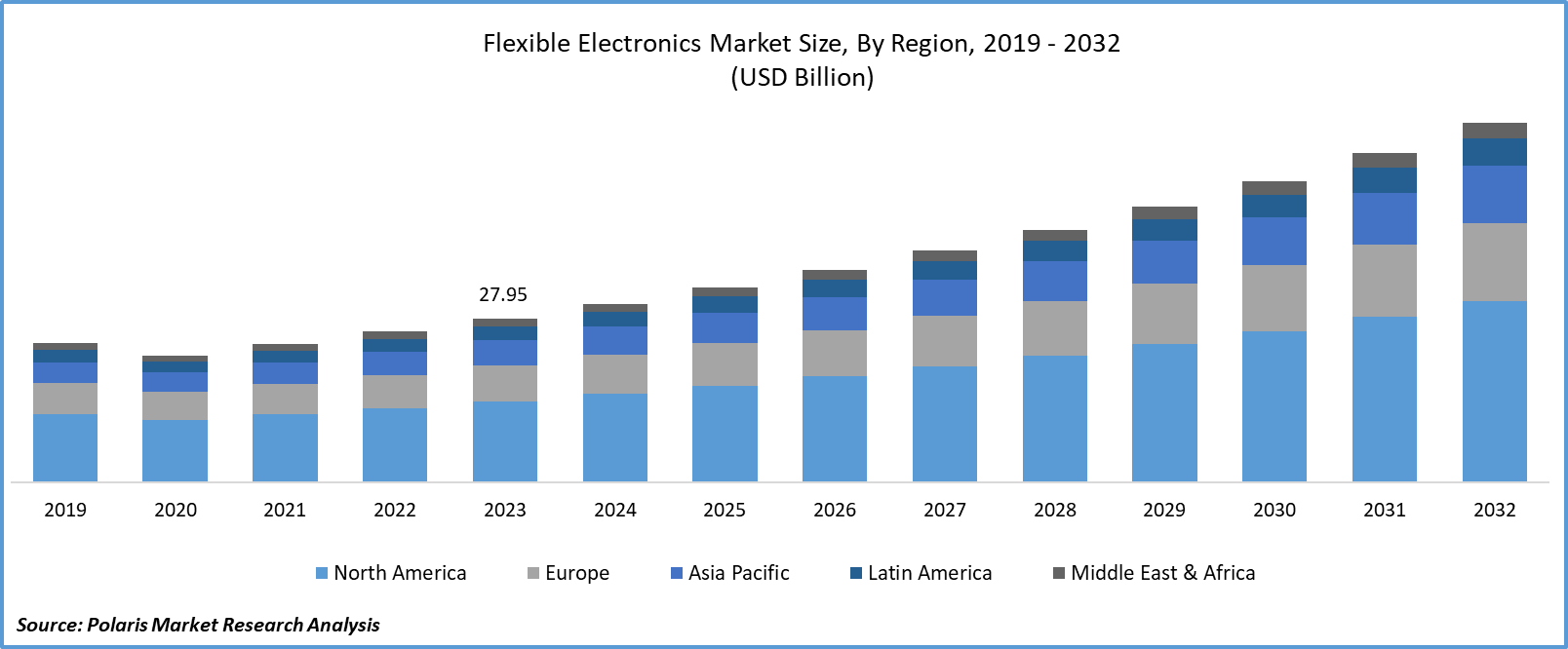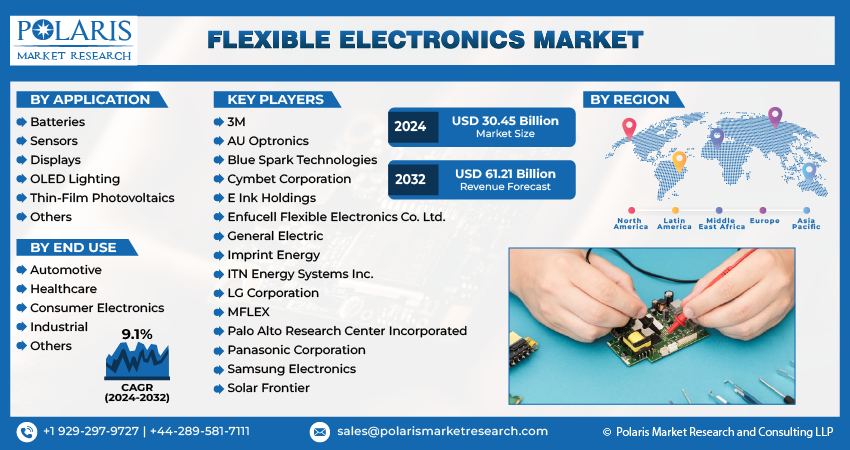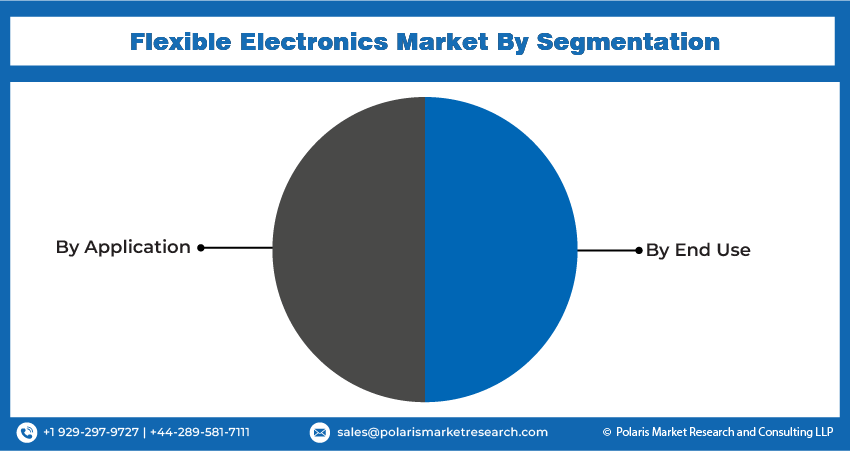
Flexible Electronics Market Share, Size, Trends, Industry Analysis Report, By Application (Batteries, Sensors, Displays, OLED Lighting, Thin-Film Photovoltaics, Others); By End Use; By Region; Segment Forecast, 2024- 2032
- Published Date:Jan-2024
- Pages: 115
- Format: PDF
- Report ID: PM4304
- Base Year: 2023
- Historical Data: 2019 – 2022
Report Outlook
The global flexible electronics market was valued at USD 27.95 billion in 2023 and is expected to grow at a CAGR of 9.1% during the forecast period.
The healthcare sector benefits from flexible electronics by incorporating them into wearables and medical devices. These technologies enable remote patient monitoring, real-time diagnostics, and personalized healthcare solutions. The ability to continuously collect and transmit health data empowers healthcare professionals and improves patient care, driving the adoption of flexible electronics in this industry.
In addition, companies operating in the market are introducing new products with enhanced capabilities to cater to the growing consumer demand.
Product innovations, technological advancements, and the introduction of regulatory policies have been detailed in the report to enable businesses to make more informed decisions. Furthermore, the impact of the COVID-19 pandemic on the Flexible Electronics Market demand has been examined in the study. The report is a must-read for anyone looking to develop effective strategies and stay ahead of the curve.
Flexible electronics also referred to as flex circuits, refers to a class of electronic technology that can be mounted on conformable or stretchable substrates. These circuits define themselves by their bending, twisting, stretching, or conforming characteristics. Depending on the application, flex circuits can be made from conductive inks, polyimide, or printed circuits. These circuits are gaining popularity owing to the various benefits they have to offer. The flexibility and portability of flexible electronics means they can be used for a wide range of applications such as batteries, sensors, displays, OLED lighting, and thin-film photovoltaics.
Flexible electronics in the flexible electronics market can take several forms. They can be single-sided, double-sided, multi-layer, or rigid-flex. Single-sided flexible electronics come with a single layer of metal or conductive polymer, while double-sided flex electronics have two layers. Multi-layer flexible electronics are an enhanced version of single and double-sided electronics having three or more layers. Also known as hybrid flexible electronics, rigid-flex electronics incorporate rigid and flexible substrates. Advances in material science and rising demand for consumer electronics are the primary factors driving the market demand.

To Understand More About this Research: Request a Free Sample Report
For instance, in June 2021, Samsung unveiled the creation of a flexible OLED display with potential applications in forthcoming wearable devices.
The automotive industry seeks innovations in infotainment, safety, and energy efficiency. Flexible displays, sensors, and lighting solutions are used in vehicles to enhance the driver and passenger experience. These technologies support advanced features like heads-up displays, touchscreen controls, and energy-efficient lighting systems, making them essential for automotive manufacturers.
In the post-COVID landscape, the electronics market has witnessed significant shifts. Remote work and telehealth have accelerated the demand for wearable devices, emphasizing the importance of health monitoring and communication. Sustainability has gained prominence, with flexible electronics offering eco-friendly alternatives, reducing waste and energy consumption in production.
E-textiles and fashion tech are on the rise, bridging fashion and technology. The automotive sector increasingly adopts flexible electronics for infotainment and driver assistance systems. Customization and adaptability have become key to meeting the unique requirements of diverse industries. Supply chain resilience is a priority, while ongoing research and development efforts drive innovation and expansion into new applications, reflecting a dynamic market post-COVID.

Industry Dynamics
Growth Drivers
Growing Demand for Consumer Electronics, Iot Expansion, and Advancements in Material Science are Factors Projected to Spur Market Demand
Consumers seek lightweight, portable, and innovative electronic devices, including foldable smartphones and flexible wearables. The desire for more user-friendly and adaptable technology fuels the growth of the flexible electronics market. Manufacturers aim to meet these demands by developing flexible displays, sensors, and components that enhance user experiences.
The rapid expansion of the Internet of Things (IoT) demands flexible sensors, tags, and low-power devices. These flexible electronics are crucial for collecting data, tracking assets, and enabling communication in IoT networks. The IoT market's growth directly translates into opportunities for flexible electronics manufacturers to meet the increasing demand for these components.
Material science breakthroughs drive the development of flexible electronics. Researchers work on flexible substrates, conductive inks, and organic semiconductors, improving their performance, durability, and environmental sustainability. These innovations enable the production of more efficient and versatile electronic components, expanding their applications in various industries.
Report Segmentation
The market is primarily segmented based on application, end-use, and region.
|
By Application |
By End Use |
By Region |
|
|
|
To Understand the Scope of this Report: Speak to Analyst
By Application Analysis
Displays Segment is Expected to Witness the Highest Market Share During the Forecast Period
The display segment is expected to witness the highest market share during the forecast period. Flexible electronics for displays have ushered in a new era of visual communication and interactivity. Curved and foldable displays are integral to smartphones, TVs, and wearables, enhancing versatility and portability. E-paper displays replicate the look of paper and are popular in e-readers. Transparent displays empower augmented reality glasses and automotive head-up displays. These dynamic screens are found in consumer electronics, wearables, healthcare devices, and smart packaging, providing real-time data and engaging user experiences. They've also made their mark in fashion, industry, military, gaming, education, environmental monitoring, and the arts. The flexible display's adaptability continues to transform industries, enabling innovative solutions and enriched user experiences.
The batteries segment is expected to experience significant growth during the forecast period. Flexible electronics are instrumental in advancing battery technology, offering versatility in various applications. In wearables like smartwatches and fitness trackers, flexible batteries ensure comfort and adaptability. Healthcare benefits from these batteries, powering wearable health sensors and implantable medical devices like pacemakers. The Internet of Things (IoT) relies on flexible batteries for remote and connected devices. They find use in consumer electronics, such as foldable smartphones, extending usage time while maintaining portability. Beyond consumer tech, they serve in aerospace, military equipment, environmental monitoring, and energy storage systems. Flexible battery solutions enable customized form factors, compact designs, and adaptability, driving innovation in diverse industries.
By End-Use Analysis
Consumer Electronics Segment Held the Largest Market Share in 2023
In 2023, the consumer electronics segment held the largest market share. Flexible electronics have transformed consumer electronics, offering versatile applications. Flexible OLED and e-paper displays are prominent in smartphones, smartwatches, and e-readers, enabling foldable or curved screens. Wearables like fitness trackers and smart clothing rely on flexible electronics, ensuring comfort and precise data collection. Bendable smartphones and curved TVs incorporate flexible components for unique form factors. Flexible sensors, printed electronics, and smart fabrics enhance touch panels, environmental monitoring, and clothing with biometric features. Moreover, flexible electronics find use in gaming devices, smart packaging, and portable chargers, contributing to sleek, portable, and durable consumer products with innovative features and designs.
The automotive segment is expected to experience significant growth during the forecast period. Flexible electronics have significantly impacted the automotive industry, enhancing vehicle design, safety, and functionality. The use of flexible OLED and AMOLED displays has led to curved infotainment and instrument cluster displays, improving visibility and aesthetics. Head-up displays (HUDs) with transparent flexible displays provide drivers with essential information directly in their line of sight. Flexible lighting, such as Organic LED (OLED) technology, has transformed headlights and taillights, offering improved visibility and stylish design. Flexible sensors are utilized for airbag deployment, collision detection, and tire pressure monitoring systems, bolstering safety. Interior lighting, seat sensors, bendable antennas, printed electronics, and advanced in-car entertainment systems, all incorporating flexible electronics, contribute to innovative automotive solutions.

Regional Insights
North America Region Dominated the Largest Market Share in 2023
The North American region dominated the largest market share in 2023. The North American market is a thriving ecosystem marked by technological innovation and diverse applications. With key players specializing in flexible displays, sensors, and printed electronics, the region remains at the forefront of industry advancements. Notably, wearable technology adoption is widespread, driving the development of smartwatches and fitness trackers. Flexible electronics are integral to the healthcare sector, enabling remote patient monitoring and diagnostic devices. Additionally, the automotive industry relies on these components for in-vehicle displays and sensors. Government initiatives, robust R&D efforts, and sustainability considerations shape the market. Collaboration, competition, and the growth of novel applications continue to fuel market expansion.
The Asia Pacific region is anticipated to experience the fastest growth during the projected period. Asia commands a global leadership position in flexible electronics production, driven by nations like South Korea, Japan, and China, home to major industry players. Renowned for advanced manufacturing capabilities, these countries serve as ideal hubs for producing flexible electronic components, including OLED displays, sensors, and integrated circuits. The region also boasts a solid presence in consumer electronics manufacturing, with substantial investments in the development of flexible displays for smartphones, tablets, and similar devices. The continuous integration of flexible electronics across diverse sectors, coupled with ongoing innovation, propels the relentless expansion of the Asia-Pacific market.

Key Market Players & Competitive Insights
The flexible electronics market is anticipated to witness competition due to various players' presence. Major market players are constantly introducing new products to strengthen their position in the market. These players focus on product upgrades, partnerships, and collaboration to gain a competitive edge over their peers and capture a significant market share.
Some of the major players operating in the global market include:
- 3M
- AU Optronics
- Blue Spark Technologies
- Cymbet Corporation
- E Ink Holdings
- Enfucell Flexible Electronics Co. Ltd.
- General Electric
- Imprint Energy
- ITN Energy Systems Inc.
- LG Corporation
- MFLEX
- Palo Alto Research Center Incorporated
- Panasonic Corporation
- Samsung Electronics
- Solar Frontier
Recent Developments
- In June 2019, E Ink Holdings Inc., a prominent e-paper display provider, strategically invested in Plastic Logic HK to jointly advance the development of flexible electrophoretic displays tailored for wearable applications.
Flexible Electronics Market Report Scope
|
Report Attributes |
Details |
|
Market size value in 2024 |
USD 30.45 billion |
|
Revenue Forecast in 2032 |
USD 61.21 billion |
|
CAGR |
9.1% from 2024 – 2032 |
|
Base year |
2023 |
|
Historical data |
2019-2022 |
|
Forecast period |
2024 – 2032 |
|
Quantitative units |
Revenue in USD billion and CAGR from 2024 to 2032 |
|
Segments Covered |
By Application, By End Use, By Region |
|
Regional scope |
North America, Europe, Asia Pacific, Latin America, Middle East & Africa |
|
Customization |
Report customization as per your requirements with respect to countries, region, and segmentation. |
Seeking a more personalized report that meets your specific business needs? At Polaris Market Research, we’ll customize the research report for you. Our custom research will comprehensively cover business data and information you need to make strategic decisions and stay ahead of the curve.
Browse Our Top Selling Reports
AI In Healthcare Market
Cytotoxic Drugs Market
Antibiotic Resistance Market
Oral Transmucosal Drugs Market
Contract Research Organization (CROs) Services Market
FAQ's
The global flexible electronics market size is expected to reach USD 61.21 billion by 2032
Key players in the market are Blue Spark Technologies, E Ink Holdings, LG Corporation, Panasonic Corporation
North American contribute notably towards the global flexible electronics market
The global flexible electronics market is expected to grow at a CAGR of 9.1% during the forecast period.
The flexible electronics market report covering key segments are application, end use, and region.
